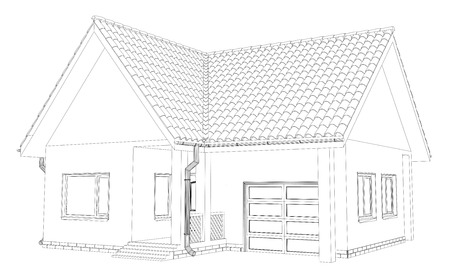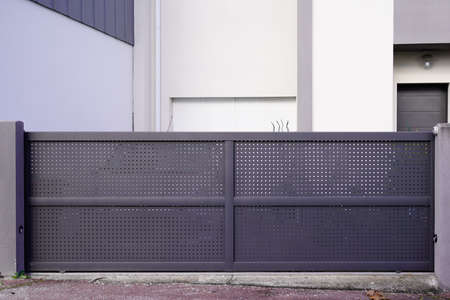1. Understanding the Importance of Privacy in Outdoor Spaces
For many American homeowners, privacy is more than just a preference—its a necessity. Our outdoor spaces are extensions of our homes, serving as places to relax, entertain, and connect with family and friends. Because of this, ensuring privacy outdoors has become a top design priority across neighborhoods from coast to coast.
Why Americans Value Outdoor Privacy
In the U.S., backyards and patios are often personal sanctuaries. With houses built closer together in many suburbs and cities, having a private outdoor space lets homeowners enjoy their property without feeling exposed to neighbors or passersby. Whether you’re grilling on the weekend, playing with kids, or simply unwinding after work, privacy helps create an environment where you feel secure and at ease.
How Privacy Influences Fence and Gate Design
The desire for privacy directly shapes choices in fencing and gate styles. Homeowners balance the need for seclusion with considerations like style, durability, maintenance, and local regulations. Here’s a quick look at how these needs influence design decisions:
| Privacy Need | Fence & Gate Design Response |
|---|---|
| Blocking views from neighbors | Tall fences (6 ft+), solid panels, minimal gaps |
| Noise reduction | Thicker materials, dense wood or composite boards |
| Curb appeal | Decorative gates, mixed materials (wood + metal), color matching home exterior |
| Easy access for residents | Secure but convenient gate latches or smart locks |
| Pet and child safety | Gates with tight closures, fences with minimal openings at the base |
Popular Materials in American Fencing for Privacy
- Wood: Classic choice for full-privacy designs; can be stained or painted to match home aesthetics.
- Vinyl: Low-maintenance and durable; available in a range of heights and styles for maximum privacy.
- Metal (Aluminum/Iron): Often combined with panels or greenery for enhanced seclusion while maintaining an upscale look.
- Composite: Eco-friendly option that mimics wood but resists weathering and fading.
The combination of thoughtful fence and gate design not only boosts privacy but also reflects the personality of the homeowner and adds long-term value to the property. In the next sections, we’ll dive deeper into how to blend style with function for ultimate outdoor privacy.
2. Balancing Aesthetics and Functionality in Fence and Gate Selection
When it comes to creating a private outdoor space, the right fence and gate can do more than just mark boundaries—they also set the tone for your home’s exterior style. In the U.S., homeowners are increasingly looking for designs that combine both security and curb appeal. Let’s explore some of the most popular materials, styles, and design trends that strike this balance perfectly.
Popular Materials for Fences and Gates
| Material | Key Benefits | Common Styles |
|---|---|---|
| Wood | Natural look, customizable, classic charm | Picket, horizontal slat, privacy panels |
| Vinyl | Low maintenance, weather-resistant, modern finishes | Solid panel, decorative lattice tops |
| Metal (Aluminum/Iron) | Durable, high-security options, elegant appearance | Ornamental, wrought iron, sleek verticals |
| Composite | Eco-friendly, mimics wood grain, long-lasting color | Contemporary slats, board-on-board |
| Bamboo | Sustainable, unique texture, tropical vibes | Bamboo roll fencing, woven panels |
Top Design Styles Across America
- Modern Minimalist: Clean lines and simple silhouettes—think horizontal wood planks or black aluminum frames—for a sleek look that matches contemporary homes.
- Classic Americana: White picket fences and arched gates create a timeless welcome that suits suburban neighborhoods.
- Craftsman & Rustic: Natural wood grains with decorative posts or stone columns blend beautifully with nature-inspired landscapes.
- Farmhouse Chic: Board-and-batten fencing paired with sliding barn-style gates gives a cozy yet practical vibe.
- Urban Industrial: Metal mesh or corrugated steel panels offer both privacy and a bold architectural statement for city dwellers.
The Security + Curb Appeal Equation
A great fence and gate design should do more than just keep unwanted visitors out—it should also enhance your home’s first impression. For example, solid panel fences with minimal gaps provide excellent privacy and deter intruders, while decorative elements like latticework or post caps add visual interest from the street. Many American homeowners are also mixing materials—such as pairing stone pillars with metal gates—to achieve both strength and style.
User-Friendly Features to Consider
- Smart Locks: Integrating keyless entry or WiFi-enabled locks on gates adds convenience without sacrificing security.
- Automatic Gate Openers: Popular in suburban settings for driveways—these make daily life easier while keeping kids and pets safe inside.
- Drought-Resistant Finishes: Especially important in hot or dry U.S. regions; powder-coated metals or treated woods help fences last longer with less upkeep.
Selecting the right combination of fence and gate material—and matching it to your home’s character—can transform your outdoor area into a secure sanctuary that also turns heads in the neighborhood. Stay tuned for our next section as we dive deeper into layout planning for maximum privacy and flow.

3. Integrating Fences and Gates: Cohesive Design Strategies
When it comes to creating outdoor privacy, blending your fence and gate design isn’t just about function—it’s also about achieving a harmonious look that feels intentional and welcoming. A well-integrated fence and gate system can enhance curb appeal while providing the privacy you need. Here’s how you can make sure your fence and gate work together seamlessly, reflecting both your personal taste and the character of your home.
Matching Materials and Colors
The first step to cohesive design is choosing materials and colors that complement each other. For example, if you have a classic white picket fence, opt for a matching white wooden gate or one with similar trim details. Modern homes might benefit from sleek metal fences paired with gates in the same finish. Consistency helps everything flow visually.
| Fence Material | Gate Material | Recommended Color/Finish | Style Match |
|---|---|---|---|
| Wood | Wood or Metal with Wood Accents | Natural stain, White, Gray | Traditional, Cottage, Rustic |
| Vinyl | Vinyl or Powder-Coated Metal | White, Tan, Custom colors | Modern, Suburban |
| Metal (Aluminum/Wrought Iron) | Metal (Same type) | Black, Bronze, Custom powder coat | Contemporary, Classic Urban |
| Bamboo/Composite | Bamboo/Composite or Painted Metal Frame | Earth tones, Natural finishes | Tropical, Eco-friendly, Zen-inspired |
Aligning Heights and Proportions
A common mistake is pairing a tall privacy fence with a short gate or vice versa. For a balanced appearance, align the height of your gate with the top line of your fence. If you want extra flair, consider an arched gate that echoes shapes in your landscape or roofline but still connects visually to the fence panels.
Proportion Tips:
- If your fence is solid and tall (6-8 feet), choose a full-height gate for maximum privacy.
- Picket fences pair well with gates that mimic their spacing and height.
- Add decorative toppers or finials to both the fence posts and gate for consistency.
Selecting Hardware and Details That Tie It All Together
The little things matter! Choose hardware—like hinges, latches, and handles—that matches the overall style. Black matte hardware suits modern or farmhouse looks; antique brass works for traditional designs. Decorative elements such as post caps, house numbers on the gate, or matching lighting can further connect your outdoor structures.
Popular Hardware Finishes:
- Satin Nickel: Sleek for contemporary homes.
- Rustic Iron: Warm for cottages or craftsman styles.
- Matte Black: Versatile for most aesthetics.
- Brushed Bronze: Sophisticated for upscale designs.
Reflecting Your Home’s Architectural Style
Your fence and gate should feel like an extension of your home’s architecture. For instance:
- Cape Cod or Colonial: Choose crisp white pickets and classic cross-brace gates.
- Mid-century Modern: Opt for horizontal wood slats and minimalist metal frames.
- Cottage or Craftsman: Use natural wood tones and decorative cut-outs.
- Tudor or Victorian: Go for ornate ironwork and detailed post caps.
A unified approach not only boosts privacy but also creates an inviting first impression every time you—or guests—arrive home.
4. Custom Solutions for Unique Outdoor Spaces
Designing for Corner Lots
Corner lots offer a unique opportunity to maximize both privacy and curb appeal. When combining fence and gate designs for these spaces, its important to consider visibility from multiple street angles and community guidelines. American homeowners often prefer fences that provide privacy without making the property feel boxed in. For corner lots, using a mix of solid panels and decorative elements—like lattice tops or spaced pickets—can help achieve this balance. Placing gates at accessible yet secure points ensures both convenience and safety, especially if your driveway or walkway wraps around the corner.
Popular Fence & Gate Pairings for Corner Lots
| Fence Style | Gate Type | Best For |
|---|---|---|
| Shadowbox Wood Fence | Arched Wooden Gate | Classic American look, moderate privacy |
| Vinyl Privacy Fence | Steel Security Gate | Maximum privacy, low maintenance |
| Wrought Iron with Hedges | Decorative Iron Gate | Curb appeal, open feel with greenery |
Tackling Sloped Yards
Sloped yards are common across many American neighborhoods, and they present a special challenge for fencing and gating. The key is to design custom solutions that follow the natural grade while maintaining a cohesive appearance. Step-down or racked fences are popular choices; step-down fences create a stair-step effect, while racked fences angle the panels to match the slope. Gates can be built to swing or slide smoothly even on uneven terrain, ensuring easy access without sacrificing style or security.
Fencing Options for Sloped Yards
| Slope Solution | Description | Lifestyle Benefit |
|---|---|---|
| Step-Down Panels | Panels installed in steps down the slope | Uniform look, works well with most materials |
| Racked Panels | Panels angled to follow the grounds contour | Smoother lines, ideal for gentle slopes and pets/kids safety |
| Tiered Landscaping with Fencing | Using retaining walls and layered planting with fence above each level | Adds visual interest, combines privacy with garden space |
Integrating Landscaping into Fence and Gate Design
The modern American backyard often blends functional fencing with beautiful landscaping. Adding climbing plants like clematis or jasmine along fences softens hard lines and enhances privacy naturally. Integrating raised beds or planter boxes directly into fence lines brings color and texture right up to your boundaries. Gates can be framed by trellises or arbors covered in flowering vines for a welcoming touch that ties your outdoor space together.
Landscaping Ideas to Pair with Your Fence & Gate Design
| Feature | Description & Benefits |
|---|---|
| Trellis-Topped Fences | Add height and support for vines; boosts privacy and beauty |
| Living Walls/Green Screens | Create lush barriers using shrubs or vertical gardens; eco-friendly solution |
| Integrated Lighting | Add path lights or solar accents along gates; improves safety and ambiance |
A tailored approach ensures your fence and gate not only offer the privacy you need but also enhance your homes unique features, suit your propertys layout, and fit seamlessly into your daily life.
5. Innovative Features and Smart Technology
Upgrade Your Fence and Gate with Modern Tech
If you’re looking to blend privacy, style, and convenience in your outdoor space, today’s fences and gates offer more than just a barrier. Modern designs now come with smart features that make life easier and safer, all while looking great in any American backyard.
Smart Locks for Secure Access
No more hiding spare keys or worrying about losing them. Smart locks can be installed on gates, allowing you to open them with a code, a smartphone app, or even voice commands. These locks keep your home secure while making it easy for family and trusted guests to come and go.
| Feature | Benefit |
|---|---|
| Keypad Entry | No need for physical keys; easy access for family |
| App Control | Lock/unlock from anywhere using your phone |
| Temporary Codes | Share access with guests without giving out permanent codes |
Remote Access for Convenience
Imagine being able to open your gate while sitting inside your house or even when you’re not home. With remote access systems, you can operate gates via wireless remotes or integrate them into your home automation system. This is especially handy for letting in deliveries or visitors without needing to walk outside.
Decorative Lighting Enhances Safety and Ambiance
Outdoor lighting is about more than just seeing where you’re going—its also about creating atmosphere and boosting security. Decorative LED lights can be integrated along fences and gates to highlight pathways, add curb appeal at night, and deter unwanted visitors by brightening dark corners.
| Lighting Option | Purpose |
|---|---|
| Solar-Powered LEDs | Eco-friendly illumination without extra wiring |
| Motion-Activated Lights | Add security by lighting up when movement is detected |
| Accent Lighting | Create a stylish look that highlights the design of your fence and gate |
Why Go High-Tech?
The right combination of innovative features not only increases your property’s value but also makes everyday living smoother. Smart technology helps you manage who comes onto your property, keeps your loved ones safe, and brings a touch of modern flair to your outdoor privacy solutions—all while fitting seamlessly into the American lifestyle.
6. Planning, Permitting, and Installation Tips
Understanding Local Regulations
Before you dive into your fence and gate project, it’s essential to know the rules in your area. Every city or county in the U.S. has its own codes about fences—how high they can be, what materials are allowed, and where you can put them on your property. Start by visiting your local city hall website or calling their building department. Some neighborhoods also have HOA guidelines that might affect your design choices. Skipping this step could mean costly fines or having to redo your work.
Getting the Right Permits
Most American cities require a permit for new fences and gates, especially if they’re above a certain height (often 6 feet). Applying for permits may seem like a hassle, but it protects you from future headaches. Here’s a quick breakdown of what you’ll usually need:
| Required Item | Description |
|---|---|
| Property Survey | Shows exact boundaries to avoid disputes with neighbors. |
| Fence/Gate Plans | Basic sketches or blueprints of your design and materials. |
| Permit Application | A simple form available at your local building office or online. |
| HOA Approval (if applicable) | Needed if you live in a community with a homeowners association. |
Choosing the Right Contractor
If DIY isn’t your thing, hiring a professional can save time and ensure quality work. Look for licensed and insured contractors with solid reviews—sites like Yelp, Angi, or Google Reviews are great places to start. Ask for references and examples of past projects similar to yours. Don’t forget to get a detailed written estimate before any work begins.
Questions to Ask Your Contractor:
- Are you licensed and insured?
- Can you provide references?
- Do you handle permits?
- What is the estimated timeline?
- How do you manage unexpected issues?
Smooth Installation Process
A well-organized installation makes all the difference. Clear your fence line of debris or plants ahead of time. Mark utility lines by calling 811 (“Call Before You Dig”) so no one accidentally hits pipes or wires underground—a common safety practice across the U.S.
| Step | Tip |
|---|---|
| Site Prep | Remove obstacles and mark property lines clearly. |
| Communication | Stay in touch with your contractor for updates and quick issue resolution. |
| Inspection | Your city may require an inspection after installation; schedule this in advance. |
| Punch List | Create a checklist of final details before making the last payment. |
Tackling these steps up front helps ensure your new fence and gate look beautiful, function as intended, and keep you on good terms with both neighbors and local authorities.


